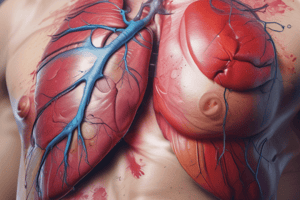Podcast
Questions and Answers
What is the primary purpose of assessing the range of motion and strength in the affected area when evaluating soft tissue damage?
What is the primary purpose of assessing the range of motion and strength in the affected area when evaluating soft tissue damage?
- To determine the extent of bleeding
- To assess the severity of pain
- To evaluate the extent of nerve damage
- To identify the type of soft tissue injury (correct)
What is a common sign of shock that is indicative of inadequate circulation?
What is a common sign of shock that is indicative of inadequate circulation?
- Rapid heart rate (tachycardia)
- Elevated blood pressure
- Pale, cool, or clammy skin (correct)
- Rapid breathing rate (tachypnea)
What is the recommended method for cleaning a wound?
What is the recommended method for cleaning a wound?
- Using tap water and mild soap
- Using saline solution or sterile water (correct)
- Using hydrogen peroxide and scrubbing the area
- Using antibacterial soap and warm water
What is a non-pharmacological method for managing pain?
What is a non-pharmacological method for managing pain?
What is a important consideration when applying immobilization devices?
What is a important consideration when applying immobilization devices?
Flashcards are hidden until you start studying
Study Notes
Assessing Soft Tissue Damage
- Evaluate the extent of the injury by assessing:
- Depth and size of the wound
- Presence of bleeding, swelling, or deformity
- Range of motion and strength in the affected area
- Sensation and circulation distal to the injury
- Identify the type of soft tissue injury:
- Contusions (bruises)
- Lacerations (cuts)
- Abrasions (scrapes)
- Avulsions (tearing of skin and underlying tissue)
Recognizing Shock Symptoms
- Monitor for signs of shock:
- Tachycardia (rapid heart rate)
- Tachypnea (rapid breathing rate)
- Hypotension (low blood pressure)
- Pale, cool, or clammy skin
- Anxiety, restlessness, or confusion
- Be aware of the patient's overall condition and medical history
Wound Cleaning and Dressing
- Clean the wound with:
- Saline solution or sterile water
- Mild soap and lukewarm water (if necessary)
- Pat dry the area with a sterile gauze
- Apply a sterile dressing to:
- Protect the wound from further trauma
- Absorb drainage and promote healing
- Secure the dressing with bandages or tape
Pain Management
- Assess the patient's pain level using a pain scale (e.g., 1-10)
- Administer pain medication as directed by a medical professional
- Use non-pharmacological methods to manage pain:
- Ice or cold compresses
- Elevation of the affected area
- Gentle stretching or mobilization
Immobilization Techniques
- Use immobilization devices (e.g., splints, slings) to:
- Stabilize the affected area
- Reduce pain and discomfort
- Prevent further injury
- Apply immobilization devices carefully to avoid:
- Nerve damage
- Circulation impairment
- Increased pain or discomfort
Studying That Suits You
Use AI to generate personalized quizzes and flashcards to suit your learning preferences.




